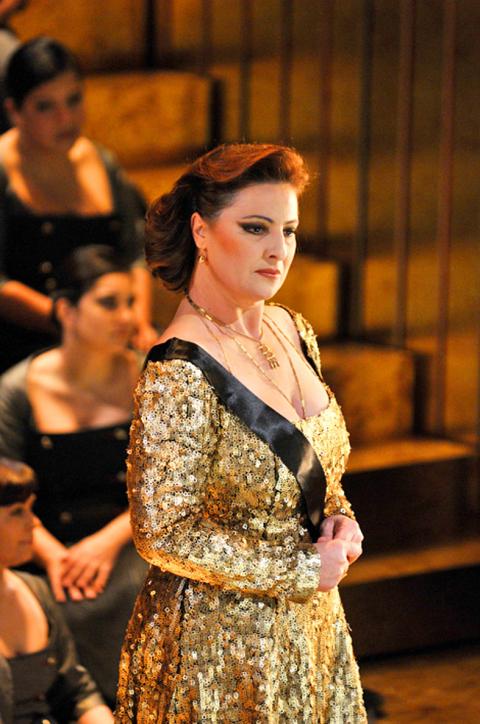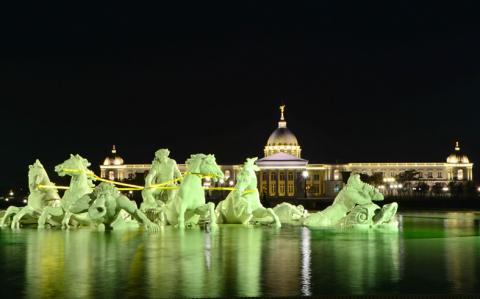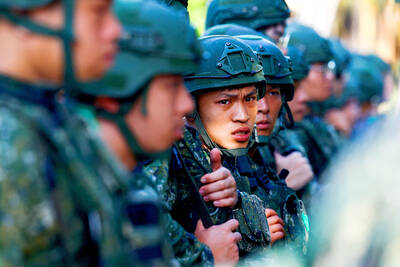Zagreb-born writer and illustrator Milan Trenc opened up a new world for museums with his 1993 children’s book The Night at the Museum, which told the story of a night watchman at New York City’s Museum of Natural History and his discovery that the dinosaur skeletons come alive at night.
The book became the basis for the 2006 film Night at the Museum and a resulting franchise, but it also inspired many museums to open their facilities up for nighttime visits, talks and explorations.
So it seems fitting that Tainan’s newest tourist attraction, the 14-month-old Chimei Museum, should team up with the city’s Cultural Affairs Bureau and Tainan Municipal Cultural Center artistic director Allen Yu (余能盛) for two nighttime concerts of Western opera highlights. After all, the museum in the Tainan Metropolitan Park boasts one of the largest collections of violins in the world, as well as other musical instruments, Western art and weaponry.

Photo Courtesy of the Tainan City Government
The “Museum Night, Opera Highlights” (博物館之夜‧歌劇選粹) concerts on June 11 and June 12 will be the culmination of this year’s three-month-long Tainan Arts Festival, which opened on March 26, and the highlight of the five-year-old festival’s “International Classics” series.
The producer for the two concerts is the Tainan-born, Austria-based choreographer Yu, who was named last year as the Tainan Municipal Cultural Center’s first artistic director.
Yu, who resigned as deputy ballet director and choreographer at the Graz Opera House to devote more time to the center and his Formosa Ballet (福爾摩沙芭蕾舞團), formerly known as the Chamber Ballet Taipei (台北室內芭蕾舞團), is using the contacts he developed over the decades he has worked at opera houses and festivals in Europe to bring more international guest artists to Tainan.

Photo: Wu Chun-fong, Taipei Times
Yu said a gala evening of opera arias is a good way to introduce Taiwanese audiences to Western opera because mounting full productions is so expensive and most local theaters lack the experience to do so.
In selecting the arias for the concert, Yu said he picked the most famous ones from several well-known operas, but also ones that are the most difficult technically for the performers.
“Some are very emotional, some are very character-oriented, like Ariel Olympia [from Offenbach’s The Tales of Hoffman], which most Taiwanese don’t known. I want to slowly introduce lesser-known operas to Taiwan. Even if many people have heard of the songs, they don’t know the operas that they come from,” Yu said yesterday.
The program runs the gamut from serious opera classics such as Der Vogelfanger bin ich ja and Queen of the Night from Mozart’s The Magic Flute, Vissi d’arte from Puccini’s Tosca, Figaro’s Aria from Rossini’s The Barber of Seville and Nessun Dorma from Puccini’s Turandot to a selection from Andrew Lloyd Webber musicals, including Memory, The Music of Night and Don’t Cry for Me Argentina.
The singers include Greek tenor Demos Flemotomos, Italian soprano Maria Pia Piscitelli, Austrian soprano Beate Ritter, Georgian mezzo-soprano Stella Grigorian and Dutch baritone Wiard Witholt.
Dutch conductor Antony Hermus — who worked with the Yu on his 2012 ballet Romance — The Music and The Destiny of Tchaikovsky (羅曼史~柴可夫斯基的音樂與人生) and two previous productions, will conduct the Evergreen Symphony Orchestra (長榮交響樂團). The Tainan Mu-Ling Bel Canto Choir (台南牧靈美聲合唱團) will provide the backup chorus and the Formosa Ballet will also perform two short pieces.
Tickets range from NT$500 to NT$4,800, although the top seats are already sold out for the first concert, and are available online at www.artsticket.com.tw and at convenience store ticket kiosks.
There are special travel/show packages available in conjunction with the Taiwan High Speed Rail Corp, and, in addition, concertgoers will be given free admission to the museum’s permanent collections for the day of their show.
For more information about the remaining Tainan Arts Festival programs, go to: tnaf.tnc.gov.tw (in Chinese with some English).

Many people noticed the flood of pro-China propaganda across a number of venues in recent weeks that looks like a coordinated assault on US Taiwan policy. It does look like an effort intended to influence the US before the meeting between US President Donald Trump and Chinese dictator Xi Jinping (習近平) over the weekend. Jennifer Kavanagh’s piece in the New York Times in September appears to be the opening strike of the current campaign. She followed up last week in the Lowy Interpreter, blaming the US for causing the PRC to escalate in the Philippines and Taiwan, saying that as

Nov. 3 to Nov. 9 In 1925, 18-year-old Huang Chin-chuan (黃金川) penned the following words: “When will the day of women’s equal rights arrive, so that my talents won’t drift away in the eastern stream?” These were the closing lines to her poem “Female Student” (女學生), which expressed her unwillingness to be confined to traditional female roles and her desire to study and explore the world. Born to a wealthy family on Nov. 5, 1907, Huang was able to study in Japan — a rare privilege for women in her time — and even made a name for herself in the

Would you eat lab-grown chocolate? I requested a sample from California Cultured, a Sacramento-based company. Its chocolate, not yet commercially available, is made with techniques that have previously been used to synthesize other bioactive products like certain plant-derived pharmaceuticals for commercial sale. A few days later, it arrives. The morsel, barely bigger than a coffee bean, is supposed to be the flavor equivalent of a 70 percent to 80 percent dark chocolate. I tear open its sealed packet and a chocolatey aroma escapes — so far, so good. I pop it in my mouth. Slightly waxy and distinctly bitter, it boasts those bright,

“Taiwanese increasingly reluctant to give their lives to defend the island,” trumpeted a South China Morning Post (SCMP) headline last week. The survey asked whether people should be prepared to pay any price — including death — to protect Taiwan and prevent “reunification.” “The poll found that 52.2 percent of those questioned were unwilling to do so — an 8.4-point rise compared with a similar survey carried out two years ago — while 40.8 percent were willing, down four points on the previous survey,” the article said. Treated as anti-Taiwan propaganda, the piece was sent around by the usual pro-China suspects